#eumachia
Explore tagged Tumblr posts
Text
Classicstober day 2! I looked up eumachia and found out she led the fabric makers guild for a while and my brain went cool let’s think about fabric making in the ancient world and then I wrote a poem (plain text below and ignore the notes for Greek class above the poem)

Making a χιτων in the ancient world
Calloused hands and tired muscles
Undergarments ripe to be bloodied
Cloth made for destruction
Women’s work made mens hands.
It s difficult work dying fabric,
Weaving it to shape, sewing in sleeves and cutting frayed edges.
And the great granddaughter of your sons first wife will wear this dress dyed green from leaves picked and boiled.
It’s blistered work,
Moneying, soaking the fabric in urine,
Making clean cloth from dirty things.
Penelope kept it going for three years,
Shuttle up,
Pedal down,
Women’s work making mens battle scenes.
It’s heavy work, that linen.
Hours and hours of slaving at the loom.
#no shade on the quality guys I wrote this in 20 minutes#eumachia#Classicstober#Classicstober 24#Classicstober day 2#poetry#my poetry#classicstober24#my writing
11 notes
·
View notes
Text
#ClassicsTober24 Day 2: EUMACHIA
Picked by Dr Victoria Austen, Classicist and Art Historian)


6 notes
·
View notes
Text
One of the greatest tragedies of life is that I cannot sit down to have a drink and talk shit with Eumachia. Something tells me she’d be great fun.
2 notes
·
View notes
Text
Cornelia:
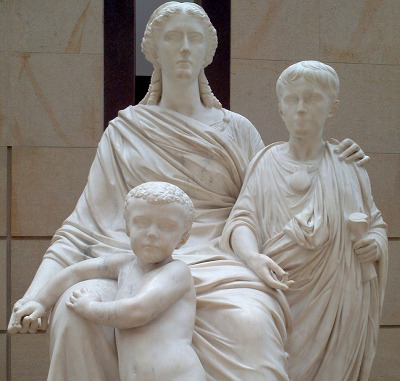
Mother of the Gracchi brothers! Highly intelligent and influential woman who educated her sons and helped shape their political careers. OG Roman MILF
Clodia

Catullus' "Lesbia" Wealthy and highly educated woman who had a talent for poetry (none survives :( ) Cicero hated her and called her "the Medea of the Palatine" (huge W for Clodia) Known for taking many lovers and accused of incest with her own brother (Catullus did not take the breakup well)
Fulvia

The first (real) woman to appear on Roman coinage. Married to Marc Antony (her third husband) and very involved in politics. Cassius Dio wrote "the following year Publius Servilius and Lucius Antonius nominally became consuls, but in reality it was Antonius and Fulvia. She, the mother-in‑law of Octavian and wife of Antony, had no respect for Lepidus because of his slothfulness, and managed affairs herself, so that neither the senate nor the people transacted any business contrary to her pleasure." Plutarch wrote "Fulvia wished to rule a ruler and command a commander and she schooled Antony to obey women." (marc antony is into femdom he's just like me fr fr) Acted as both a political and military leader.
Agrippina the Younger:

One of the most powerful of the Julio-Claudian women and a big influence on behind the scenes politics. Mother of Nero by her first husband. Was exiled for a conspiracy to assassinate her brother Caligula, but later returned. May have poisoned her second husband in order to marry the Emperor Claudius. She was the one to convince Claudius to name Nero heir, instead of Claudius' own son. May have poisoned Claudius in order to make Nero emperor. Ruthless, ambitious, and domineering #girlboss. Fave moment was when Nero engineered a boat designed to sink specifically to assassinate her. She swam to shore, realized her shitty son had tried to kill her (again), and wrote a letter to him letting him know that she had survived a terrible accident by divine fortune.
Messelina

Third wife of Claudius and hugely influential, directly responsible for the execution of several people and tried to get young Nero assassinated so that her own son would have the throne. Hated Agrippina for obvious reasons. Executed for a conspiracy to assassinate Claudius. Pliny wrote a famous (and certainly fake) story of her challenging a famous prostitute to see who could sleep with the most men in one night. (Messalina won at 25)
Julia the Elder:
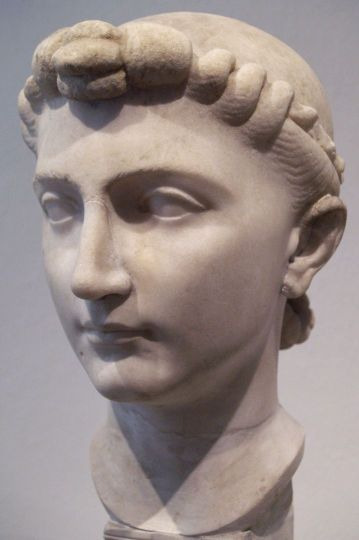
Augustus once famously remarked that he had two difficult daughters: Rome and Julia. Married off by her father several times, all for political reasons. Clashed with her controlling father on many occasions about her spending, behavior, etc. Augustus passed laws making adultery a crime and then had to exile her for adultery (after killing and exiling her lovers) She was popular with the Roman people, who petitioned for her recall from exile, and was known for her kindness, intelligence, and wit. She never returned to Rome, and died in exile.
Livia:
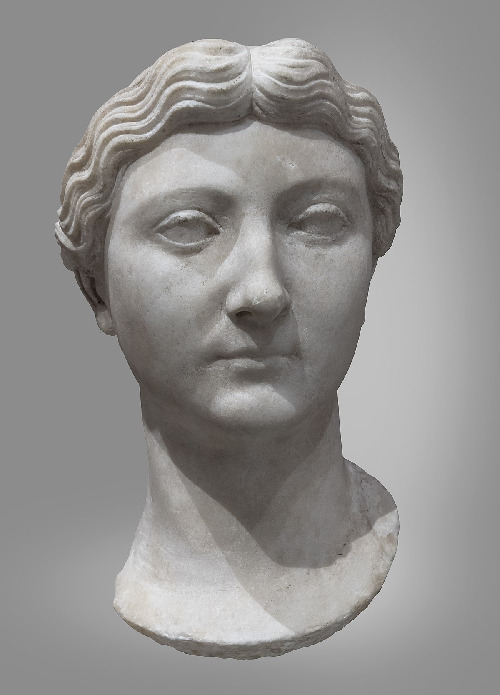
Wife of Augustus and first Roman empress. One of, if not the, the most powerful and influential women in the early Roman Empire. iirc she was the first woman to be deified. Cassius Dio wrote "Livia was destined to hold in her lap even Caesar's power and to dominate him in everything."
Hortensia
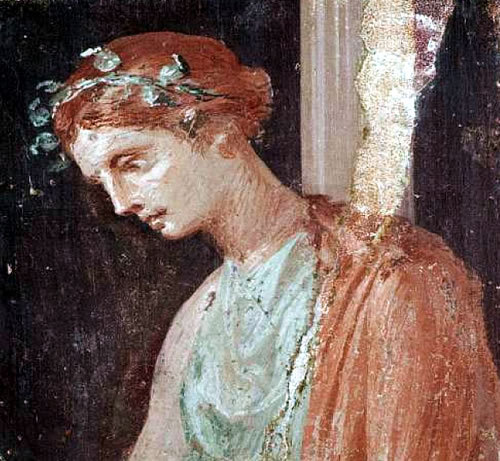
A skilled orator, best known for her public speech given in the forum in protest of a tax put on women to fund the civil war after the assassination of Caesar. She was successful, reducing the number of women taxed down to 400, with new taxes on men being levied to make up the difference. (Using this image of a fresco from Pompeii because there's, surprisingly, no art I can find of her from a google search)
Empress Theodora

Byzantine empress. She was the daughter of a bear trainer and an actress, and worked as an actress and prostitute in her youth. Married the Emperor Justinian and became his advisor, preforming jobs that were usually only done by the emperor (receiving envoys and corresponding with foreign rulers) and helped pass laws for women's rights.
#i wanted to include terentia and servilia but you can only have a max of ten#so suggestions for 'other' i guess#also wanted to keep it like. completely factual women that we know existed#but shout out to rhea silvia lucretia cloelia tarpeia etc#also wanted an honorable mention to eumachia but again#max ten options
385 notes
·
View notes
Text




Day 2 of Classicstober! Today the prompt was Eumachia, a Roman priestess and entrepreneur of Pompeii.
I took inspiration from a statue of her, I believe the images I used of the statue as reference were taken when it was on display at the British Museum.
14 notes
·
View notes
Text

Statue of Eumachia
Pompeii
1st century CE
British Museum; (Exhibition: Life and Death in Pompeii and Herculaneum)
source: Smuconlaw., CC BY-SA 4.0 https://creativecommons.org/licenses/by-sa/4.0, via Wikimedia Commons
FeminaeRomanae/Eumachia
71 notes
·
View notes
Text

Commission of Eumachia, priestess of the imperial cult of Pompeii for @ubiest .
151 notes
·
View notes
Text
THREE WOMEN/THREE PATRONS
In stark contrast to ancient Greece, the Romans had no use for the cult of the artist. The native sculptors, painters, mosaicists, and goldsmiths produced copies of Greek works or adapted from Greek sources, were freedmen or slaves whose names are not preserved and whose personal contribution to their work was minimal. When Roman patrons commissioned works from Greek artists (or looted masterpieces by classical artists), those names were often dutifully recorded. Architects were also freedmen, but commanded a little more respect, perhaps because the Romans knew that in this area their architects surpassed Greece in technical ability and iinnovation.
We also know that while the Roman elite recognized and valued high degrees of technical skill workmanship in the artists they patronized, the viewed those manual abilities as inappropriate for members of their own class and looked askance at their social peers who attempted to practice the visual arts. Capable emperors like Hadrian and Julian who took an interest in a manual activities including art, were thought to have degraded the purple in doing so.
Roman art has therefore been largely viewed as the product of an elite patron, who had no direct experience of making art, but whose taste, education, and class informed his/her choices of style, iconography and materials. The work art expresses the patron’s concerns, ambitions, and assumptions, without ever being “expressive” in the psycho-personal, modern sense. Unlike their Greek counterparts, the role of patron in ancient Rome was much more open to women. The following three examples demonstrate the real ways in which privileged Roman women used artistic patronage to assert themselves in the public sphere and to exercise limited, but meaningful, forms of political power.
I. EUMACHIA OF POMPEII
Nearly everything known today about Eumachia stems from epigraphic inscriptions found in Pompeii. The longer of two inscriptions on the building bearing her name adjacent to the Forum identifies her as the priestess of the cult of Venus Pompeiana. The priestess was the sole female member of the city council. Obtaining the position required great wealth and high social rank and the same inscription suggests Eumachia had both: she was the heiress of a successful brick and tile manufacturer and the wife of a patrician duumvir.

In addition to her role as priestess, Eumachia was the patron of Pompeii’s fuller’s guild. In the second decade of the 1st century, she paid for the construction of an enormous elegant building, which served as the meeting place and/or the workshop for the guild. A togate statue representing Eumachia placed in a niche inside the building was donated by the guild in her honor. The inscription also notes that the building was the building was dedicated to Concord and the pax augusta, which indicated that Eumachia wished to be known as a supporter of the imperial government.

Eumachia also commissioned the largest tomb in Pompeii. The elaborate monument exceeded the city’s limits placed on tomb size and surpassed the size of the mausolea of her male colleagues on the council.
II. AGRIPPINA THE ELDER
The daughter of Marcus Agrippa and Augustus’ daughter Julia was married to Germanicus, the most esteemed and capable general in Rome’s history and the adoptive son of Tiberius. After the untimely death of Germanicus, Agrippina actively promoted the sons of Germanicus as potential heirs to Tiberius. In pursuit of this goal, she commissioned one of the most important works of Roman art, the so-called Grand Camée de France.

The largest cameo to survive from antiquity was probably given to Tiberius, who is depicted at the center of the middle register. In the upper register, which signifies the divine realm, the deified Augustus is joined by Drusus and Germanicus. Seated next to Tiberius in the realm of the living is Livia (which dates the cameo to before AD 27). Alsc present are Germanicus and Agrippina with their sons Nero Julius Cæsar, Drusus, and Gaius (Caligula). After the death of their father, the older two boys were adopted by Tiberius. Both were dead by AD 31. Below, captive barbarians served to remind Tiberius of the glorious victories of Germanicus.
Following the example of Augustus, the Julio-Claudians were avid collectors of cameos and intaglios. Agrippina would have been familiar with the most accomplished gem carvers and the works they produced, including the Gemma Augusta. The size, refinement and complexity of the Grand Camée could not have failed to make an impression on Tiberius and Agrippina’s goal was eventually fulfilled: Caligula inherited the throne after the rest of his family, including Agrippina, was exterminated during the ascendancy of Sejanus. The priceless object proves that with access to unlimited resources Roman women could surpass their male counterparts in the commissioning of lavish artworks designed to serve as instruments of political power.
III. GALLA PLACIDIA
Galla Placidia was the daughter of Emperor Theodosius I, the sister of the Emperors Arcadius and Honorius, the mother of Emperor Valentinian III, and the aunt of Emperor Theodosius II. She was given the title Augusta in 421. Galla Placidia, Eudoxia, the wife of Theodosius II, and Pulcheria, the sister of Theodosius II effectively ran the eastern and western empires together during the minorities of Valentinian III and Theodosius II.
As the de facto ruler of the western empire, Galla Placidia engaged in many acts of imperial architecture patronage. She restored the churches of San Paolo fuori le mure in Rome and the Holy Sepulchre in Jerusalem. In Ravenna, she founded the basilica of San Giovanni Evangelista and commissioned the building known today as the Mausoleum of Galla Placidia, which was in fact an Oratory, attached to the narthex of the palace chapel of Santa Croce. After her death in 450, Galla Placidia was buried in the Theodosian family mausoleum in Old Saint Peter’s in Rome. The sarcophagi currently in the oratory, long identified as those of Galla Placidia, Constanius III and Valentinian III, were placed there at a later date.

The interior decoration of the oratory is the product of Galla’s refined tastes and unlimited resources. The mosaic depicting Christ as the Good Shepherd is a masterpiece of Late Antique art, seemlessly combining elements of Greek pastoral imagery, classical figuration, and imperial Roman iconography.
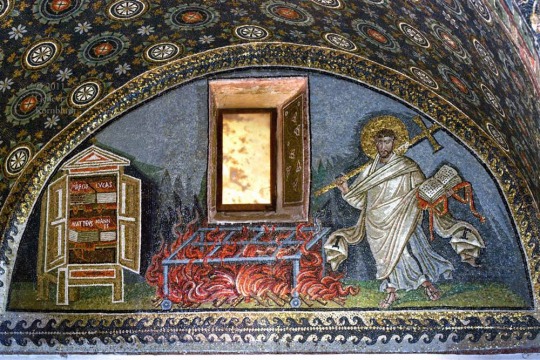
The mosaic representing a saint with a flaming grille was traditionally thought to depict St Lawrence. It has been argued,* however, that this panel represents the Spanish Saint Vincent of Saragossa. Evidence for this theory includes the facts that 1) Galla Placidia had Spanish connections through her first husband, Ataulf, the King of the Visigoths; 2) St. Vincent was martyred by drowning at sea, and Galla had founded San Giovanni Evangelista after she and her children had been delivered from a shipwreck; and 3) Prudentius's fifth century Passio Sancti Vincent Martyris recounts how Vincent was ordered to disclose his sacred books, so they could be burned. This explains the conspicuous representation of a late antique bookpress, containing the labeled codices of the Gospels, which has no satisfactory explanation in the story of St. Lawrence. This interpretation ties Galla Placidia personally to the mosaic program, proving that female patrons (of this class) had the freedom to commemorate their own experiences and personalize, not just pay for, official monuments.
(*) Mackie, Gillian, “New Light on the So-Called Saint Lawrence Panel at the Mausoleum of Galla Placidia, Ravenna". Gesta 29:1 (1990), 54–60.
#roman art#patronage#eumachia#pompeii#agrippina maior#rome#galla placidia#ravemna#mosaic#cameo#mausoleum
92 notes
·
View notes
Photo

Estatua de Eumachia, sacerdotisa de Venus e dona dun lanificio, atopada ao leste do Foro de Pompeia
1 note
·
View note
Text
Last Week of Summer Courses
I have the final for my class on Pompeii and the cities of Vesuvius tomorrow!
I have a series of potential essay prompts I’ll have to write about, so I’ll maybe write a paragraph about each that can potentially be expanded into a full essay here :)
PART 1
1) Considering what you’ve learned regarding the history of excavations in Herculaneum and Pompeii from the early 18th century to the present, what are the pros and cons of further excavation at these sites?
The excavations in Herculaneum and Pompeii were done in destructive and haphazard ways. They used gunpowder to excavate the sites, looking for artwork to loot. If they didn’t deem it as being valuable enough to them, they quite literally threw it away. Not only did they not record their findings, or draw the art they discovered, but they actively discouraged the practice until much later. Modern archaeology has come a long way since then, and in my opinion, it seems that it would be a waste to stop excavating only after learning better methods. Excavation now is significantly less invasive, and recording findings is now easier than ever. The upside to continued excavation is that there’s still so much left to learn about these peoples and the way their society functioned. We have a lot of unanswered questions still, and further excavation could illuminate those answers. The downside is, of course, that preservation is painfully difficult. Conservation is already hard to manage for the sites, and adding more to worry about could spread the resources too thin.
2) What do you feel the priorities should be for archaeologists and Italian officials? Why? Ultimately, do you think we should continue to excavate the ancient Roman cities of Vesuvius? Why or why not?
I touched on this a bit above, but I think we should continue to excavate the ancient Roman cities of Vesuvius. There’s still so much left to discover, and it seems like a huge waste to stop excavations only after we finally learn less invasive techniques and have a more complete historical framework to place findings into.
3) Based on what you’ve learned in regards to entertainment, religion, and bathing in Pompeii, discuss how the archaeological evidence from Pompeii reveals information about the lives and roles of women in Roman Campania. Feel free to discuss relevant buildings, artifacts, paintings, inscriptions, sculptures, monuments, and forensic evidence to help support your claims.
The House of Julia Felix shows that women could be wealthy and own property in Pompeii. She rented out these properties, as evidenced by surviving documents and advertisements found. Her property was filled with unique paintings and statues. Julia was an influential business woman, and her villa reflects this.
Another woman with significant status in Pompeii is Eumachia. She married into a powerful family in Pompeii, and became the matron of the Concordia Augustus and the fullers, who constructed a statue in her honor. She funded the Building of Eumachia to gain even more status for her and her son, Marcus Fronto. Even her tomb was impressive; rather than a monument, she had a complete building to rest in.
While these two women do show that social mobility and self-agency was possible, it was not the case for all women in Pompeii. Women were still denied the right to vote or hold office, nestling them between the upper-class and the slave-class. They could not sit in prime theater seats, and were relegated to stay with the slaves regardless of their own social status.
They could become gladiatrices, however, and fight in the arena. They could participate in sports, and artistry portrays them running, throwing discus, and playing ball games. It’s not yet known how common this was; archaeologists and historians used to think it never even happened at all, but recent findings have debunked that.
It is also still unknown how many brothels Pompeii had, but it’s highly likely that women and slaves were regularly used for sex. There is highly sexual graffiti, countless lewd wall paintings, and a tax on prostitution. Young girls were married off, with a premium placed on virginity. These all point to the likelihood of sex having been a thriving industry, but most women involved had little say in the matter.
TL;DR
The life you held as a woman in Pompeii was related to your social status, but even if you belonged to the upper echelons of society, you wouldn’t have much agency in your life. Eumachia and Julia Felix did enjoy more freedom and luxuries than the average Pompeian woman, and they prove that social mobility was possible; just less common.
#studyblr#history#Pompeii#20170824#roman history#vesuvius#eumachia#herculaneum#archaeology#women in history#essay prompts#wleaf
2 notes
·
View notes
Text

Concordia Augusta (I sec.), dall'Edificio di Eumachia - Pompei, Museo Archeologico Nazionale, Napoli.
458 notes
·
View notes
Text

✨Welcome to ClassicsTober 2024!✨
The idea is to create something – anything – for the prompt. Like other October prompt lists, it can be an illustration, but it can also be text, reference, historical artefact, video, story, translation, pretty much anything you’re interested in from the Ancient Med World that fits with the prompt. There’s no pressure to do every single one, just the ones you like.
This year it’s an ANCIENT HISTORY TAKEOVER! We asked Classicists, Ancient Historians, Archaeologists and Authors we know and love to suggest an ancient personage that they think everyone should know about! And, to combat misinformation and encourage research, we invite you to share your sources with your submission, whether that’s image references, texts, or even a whole bibliography!
✨NO AI USAGE ALLOWED✨
See the ClassicsTober24 Details page for background on each of the names chosen by our friendly Classicists, Archaeologists, Historians and Authors, to get your creativity going! https://greekmythcomix.com/classicstober-24-details/
THE LIST:
1 Regina of South Shields
2 Eumachia
3 Thucydides
4 Cleopatra Selene
5 Pliny the Elder
6 Meleager of Gadara
7 Harmodius and Aristogeiton
8 Boudicca
9 Eritha
10 Vitruvius
11 Julia Felix
12 Homer
13 Zenobia
14 Kallistomache
15 Aesop
16 Elagabalus
17 Iphikrates
18 Tacfarinas
19 Vespasian
20 The Trung Sisters**
21 Marcus Aquilius Regulus
22 Martial
23 Corinna
24 Cleopatra Thea
25 Sappho
26 Vitellius
27 Menander I Soter
28 Crassus
29 Phryne
30 Flavius Cerialis
31 Sejanus
*Ancient Greece and Rome and other near-Mediterranean Ancient cultures
**wildcard!
#classicstober#classicstober24#roman history#Greek history#Ancient Greece#Ancient Rome#Roman#ancient greek#egyptian#egyptian history#ancient historical figures#historical figures#illustration#art#writing#poetry#video#no Ai#no ai art
83 notes
·
View notes
Note
hi! can you please make a list of ancient roman inspired names, including some that are less common/not straight from mainstream mythology? thank you!
— 𝐀𝐍𝐂𝐈𝐄𝐍𝐓 𝐑𝐎𝐌𝐀𝐍 𝐍𝐀𝐌𝐄𝐒
below is a list of ANCIENT ROMAN inspired names. they are in alphabetical order, and split into 'masculine' and 'feminine' and 'unisex', for easier access. please LIKE / REBLOG if you find this list useful!
— 𝐌𝐀𝐒𝐂𝐔𝐋𝐈𝐍𝐄
Accius
Acilius
Acutius
Adiutor
Aedius
Aelianus / Aelius
Aemilianus / Aemilius
Aetius
Africanus / Afranius
Agathus
Agellus
Agricola
Agrippinus
Ahenobarbus
Akylas
Akylinos
Albanos / Albinianus / Albinius / Albinos
Alexinos / Alexinus
Amadias
Amicius / Amicus
Ampliatus
Ancus / Anicius
Annalis
Ansanus
Antoninos
Aphrikanos
Aquillius
Arrius
Arruns / Arruntius
Asper
Attius
Aufidius
Augoustinos / Augoustos
Augur
Aulos
Aurelianos / Aurelios
Aurius
Ausonius
Balbinos
Basolus
Bassianus
Bibulus
Blaesus
Blossius
Bonus
Britannicus
Broutos / Brutus
Caesarion
Calpurnianus
Caninius / Canius
Capito / Capitolinus
Cartilius
Carus
Carvilius
Casca
Castricius
Castus
Catullus
Caudex
Ceionius
Cicerón
Cincinnatus
Cinna
Clateus
Clodius / Cordius
Corellius
Coriolanus
Cornificius
Coropas
Corvus
Cossus / Crassus
Curius / Curtius
Dacianus / Dacius
Damasippus
Damasius
Datius
Decius
Defendens
Dentatus
Diaulus
Diocletius
Dolabella
Drousos / Drusianus
Equitius
Eulalus
Eumachius
Favian / Favonius
Martinos / Martius
Marullus
Maternus / Maturinus
Maxentios / Maximinos
Memmius
Messala
Metellus
Mettius
Minatus
Minervinus / Minervius
Miniatus
Minius
Montanus
Mucius
Munatius
Natalis
Naucratius
Necessitus
Nerius
Neron
Neroua
Nervas
Noma
Novatus / Novius
Numerius
Nymphias
Opimius
Opiter / Opiternius
Oppius
Optimus
Orestinus
Ostorius
Oualentinianos / Oualentinos / Oualerianos / Oualerios
Ouespasianos
Ouiktor
Oursos
Ovius
Paccius
Patrobas
Paulinos / Paullus
Pergentinus
Pertinax
Phabianos / Phabios / Phabrikios
Phaustinos / Phaustos
Phillipus
Phloros
Phourios
Pictor
Plautus
Pompo
Pontios
Poplios
Poppaeus
Portian / Portius
Poublios
Priscillus
Priskos
Probus
Processus
Proculus
Propertius
Pupillus
Quartus
Quintianus
Quiricus
Radix
Regoulos
Romanicus
Romulan / Romulanus
Roscius / Rosius
Rouphinos / Rouphos
Rullianus / Rullius / Rullus
Rupilius
Russus
Rutilius
Sabinos
Salinator
Sallustius
Satorninos / Satourninos
Savinus
Sawiris
Scaurus
Scribonius / Scribonus
Sedulius
Sekoundos
Sempronius
Senekas
Seouerianos / Seouerinos / Seoueros
Seppius
Serenos / Serenus
Sergios
Serouios
Sertor
Servilianus / Servilius
Servios
Severianos / Severinos / Severos
Silius
Sosius
Sporus / Spourios
Statilius
Statius
Sulpicius
Surdinius / Surdinus
Symphorus
Tarkynios
Tenagino
Terentios
Thrax
Tiberinus
Tibullus
Titinius / Titius
Torquatus
Toullios
Trebius
Turpilius
Ulpian
Ummidius
Valentinianos / Valentinos / Valerianos / Valerios
Varro / Varus
Venustian / Venustianus
Verus
Vespasius
Vettius
Vicesimus
Vinitius
Vipsanius
Viridianus / Viridius
Volesus / Volsus
— 𝐅𝐄𝐌𝐈𝐍𝐈𝐍𝐄
Accia
Aconia
Acutia
Adelphasium
Aedia
Afrania / Africana
Aimilia
Akylina
Albinia
Amica
Anicia
Aniensis
Annia
Appia
Aquilia
Arria
Arruntia
Atia
Aufidia
Aula
Aureola
Auria
Avidia / Avita
Blanda
Caenis
Caesillia / Caesula
Caia
Caietana
Capitolina
Cartilia
Carvilia
Cassiana
Castricia
Ceionia
Cordia
Corellia
Cornificia
Crispina
Curia
Cypriana
Dacia
Domitiana
Drusiana
Eumachia
Felicula
Ferocia / Ferocilla / Ferocina
Floridia / Floridiana
Furia
Furnia / Furnilla
Fusca
Fuscinilla
Hostilia
Iaia
Ianouaria
Invidia
Ioulia / Iouliana
Ioulitta
Iuventas
Januaria
Joviana
Kaikilia
Kouinta
Lepida
Licinia
Livilla
Lollia
Loukilla
Loukretia
Lucillia
Luciola
Maecia
Mamerca
Mania
Materna
Maxentia
Maximiana / Maximina
Mercuria
Messalina
Metella
Mettia
Milonia
Mucia
Munatia
Naevia
Necessitas
Neruia
Novia
Octaviana
Opimia
Oppia
Orestilla
Orestina
Oualentina
Oualeria / Oualeriana
Phabia / Phabiana
Phausta / Phaustina
Pompeia / Pompilia
Poppaea
Potita / Potitia
Procula
Pulchra
Quadratilla
Quarta / Quartilla
Quieta
Quinta / Quintia / Quintiana
Quintilia / Quintiliana
Romilia / Romula
Roscia / Rosia
Rupilia
Rutilia
Sagitta
Sallustia
Saturna
Scaura
Scribonia
Sebine
Secunda / Secundilla
Sedulia
Semperbella
Sempronia
Seouera
Sertora
Servilia
Severa / Severiana / Severilla
Statilia
Stellatina
Sulpicia
Surdinia
Sympherusa
Symphora
Tatia
Terentia
Tiberia
Tita / Titia / Titinia
Tuccia
Turia
Ulpia
Ultima
Vipsania
Viridia / Viridiana
Vistilia / Vitalina
Vitellia
Volesa / Volusa / Volusia
— 𝐔𝐍𝐈𝐒𝐄𝐗
Agrippa
Aquila
Glaucia
Iovita
Merula
156 notes
·
View notes
Photo




My attempt at Terentius Neo and his wife which has taken far too long
#m#photo#i named her eumachia bc thats the most famous pompeiian woman#gonna try and make a semi-historically accurate roman domus bc fuck it
56 notes
·
View notes
Text

Doorway to the building of Eumachia, Pompeii. The marble frame of the doorway, beautifully decorated with acanthus leaves, is original.
27 notes
·
View notes
Photo

Eumachia, a gift to the people,, (at Melbourne, Victoria, Australia) https://www.instagram.com/p/CY06jyCBrg0/?utm_medium=tumblr
4 notes
·
View notes